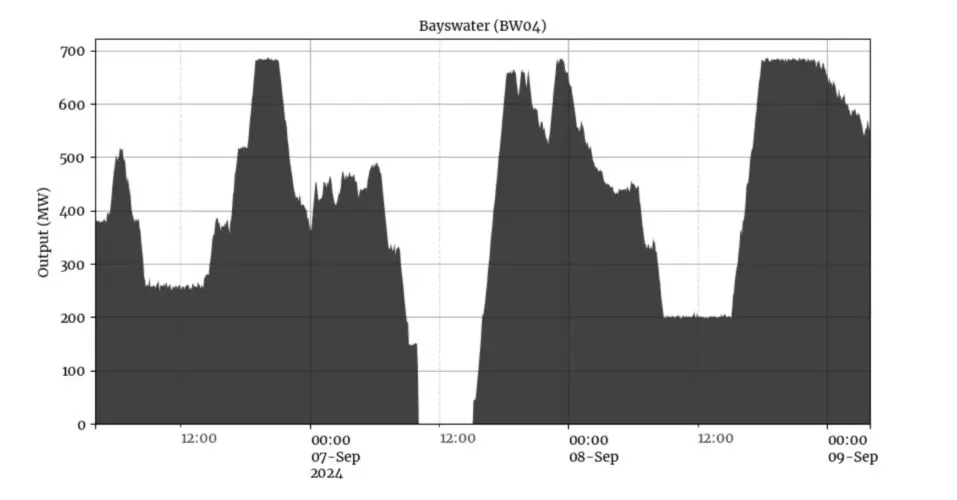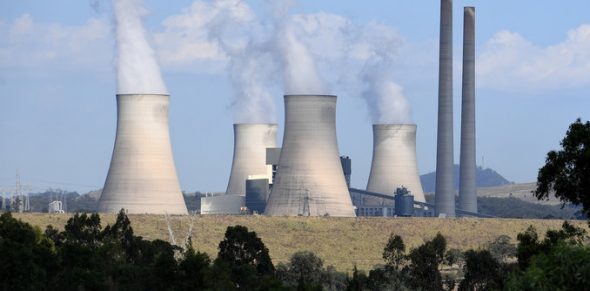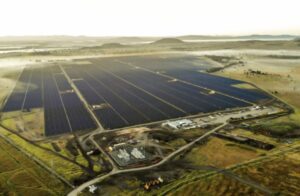Australia’s biggest coal generator AGL Energy has reported success with a ground breaking initiative that will allow it to shut down coal units in the middle of the day, effectively making way for rooftop and large scale solar to dominate the grid.
The first trials have been held at AGL’s Bayswater generator, next to the already shuttered Liddell facility in the Hunter Valley, and involves a process called “two-shifting” – meaning it takes a unit offline and brings it back online within a 12 hour period.
The milestone was reported by Len McLachlan, the head of AGL operations at Bayswater, who said his team had learned from a visit last year to the Ratcliffe coal fired power station in the UK, which switched off for the last time on Tuesday morning (Australian time), ending a near 143 year era of coal generation in the UK.
“Our team desynchronised 20 seconds ahead of the 10am target and resynchronised within 50 seconds of the 3pm target. This level of precision on our first attempt is extraordinary and sets a new benchmark for our operations,” McLachlan wrote on LinkedIn.
“Looking forward to pushing the boundaries.”

Energy industry insiders said the significance of this development – which appears to have occurred on Saturday, September 7 – should not be underestimated.
Right now, the main reason for wholesale electricity prices to go negative so often is because coal generators think it is not possible to switch off their units without incurring significant economic cost and damage to the machines.
They have learned how to ramp down by as much as 80 per cent of their rated capacity in response to the gyrations of rooftop solar, and the growing solar duck curve that emerges in the middle of the day, but have been prepared to bid negative prices to ensure they are dispatched by the market operator and stay on line.
That has an impact on other generators, forcing wind and solar farms to shut down – often because their contracts require them to do so when prices are negative – and leading to large amounts of what is called “economic curtailment”. In some cases, more than 90 per cent of large scale solar farms have been switched off.
The ability of coal generators to turn their own units off could allow more wind and solar production, and provide more incentive for additional projects to be built.
“It will be interesting to see if this becomes common practice,” says Dr Dylan McConnell, an energy systems analyst at UNSW. “It’s one thing to be technically capable of doing this – it’s another for it to be economically viable. It’s also more of a stay of execution rather than something will significant extend coal generation.
McConnell says this kind of capability is implied by the market operator’s Integrated System Plan and the 82% renewable energy target now adopted by the federal government.
“A system with this much renewable generation will have significant periods of at or near 100% renewable energy – the balance is necessarily highly flexible like this. It would be a valuable capability to have as coal exits this.”
If it can be done for a period of hours, then perhaps they could be done on a seasonal basis, as the head of EnergyAustralia, Mark Collette, has suggested for that company’s Mr Piper coal generator in NSW.
The only technology grumbling about this development might be big batteries, who might see less of the volatility in prices they depend on, and of course the nuclear boosters who might find it difficult to replicate these capabilities with their technology.
AGL is looking to introduce this as part of the next phase in its transition to “flexibility”, in recognition of the transition to a grid dominated by renewables.
It wants to keep Bayswater open until 2032 or 2033 and its Loy Yang A coal generator in Victoria until 2035, and is investing in a suite of big battery projects and also some fast-start gas generators.
In effect, the trial confirms the end of the “base-load” construct that has been developed by the coal and nuclear industries.
It was once the central principal of grid operations, to have “always on” power, but with the arrival of zero marginal cost wind and solar, and the need for flexible generation, that is now going out the door. Energy experts point out that this does not mean a reduction in reliability – baseload is more a business model than a grid requirement.
McLachlan says the trial at Bayswater followed months of pre-testing, simulation training and detailed planning.
“Our Head of Generation and Revenue Christopher d’Hotman and Head of Engineering and Projects Michael Musca visited Ratcliffe Power Station in England last October to gather insights on flexible operations and their insights gave us the confidence to explore two-shifting capabilities here at Bayswater,” he wrote.
“After months of pre-testing, simulation training, and detailed planning supervised by our Performance and Flexible Operations Manager George Hague, this trial succeeded. It enables us to maximise our market involvement during peak times and avoid low-price periods.
“This achievement is a testament to the dedication and expertise of Bayswater’s teams. Our operators performed flawlessly, maintenance teams ensured system availability, and our performance and engineering teams provided crucial support.
“While it is early days and much remains to be evaluated from this first trial, we are ready to test again and continue learning as market conditions allow.”
Listen also to AEMO boss Daniel Westerman discussing the end of baseload in this recent episode of Renew Economy’s weekly Energy Insiders podcast.








